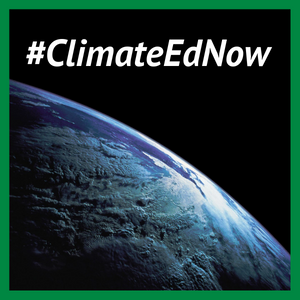 When considering the ways to mitigate, adapt to, or reverse climate change, climate action plans often focus on transportation, green buildings, and resiliency. One aspect that is often left out, but can have a major impact, is climate education. Students who engage in climate coursework have been shown to decrease their individual carbon emissions by 2.86 tons per year. Providing comprehensive climate education to the millions of students who attend K–12 schools here in the United States is an overlooked strategy. Not including climate education as a part of climate action plans is a lost opportunity for real change.
When considering the ways to mitigate, adapt to, or reverse climate change, climate action plans often focus on transportation, green buildings, and resiliency. One aspect that is often left out, but can have a major impact, is climate education. Students who engage in climate coursework have been shown to decrease their individual carbon emissions by 2.86 tons per year. Providing comprehensive climate education to the millions of students who attend K–12 schools here in the United States is an overlooked strategy. Not including climate education as a part of climate action plans is a lost opportunity for real change.
There is no area of science to which the climate cannot be applied. Teaching climate change thus offers opportunities at all grade levels to make connections between the disciplines. Although the Next Generation Science Standards do not explicitly address climate change at the elementary level, there are opportunities to integrate climate change instruction at each grade level. Kindergarten students who are learning about pushes and pulls in their “Motion and Stability: Forces and Interactions” units could learn about the pushes and pulls that allow us to fly kites, then apply that knowledge to better understand changing wind patterns due to climate change. Although the assessment boundary for the third grade standard to evaluate “a solution to a problem caused when the environment changes” explicitly says it “does not include the greenhouse effect or climate change,” there is no reason why it could not include environmental changes due to climate change. This third-grade performance expectation lists changes to “land characteristics, water distribution, temperature, food, and other organisms” as examples of the types of impacts that should be analyzed, all of which are potential changes as a result of climate change. Similarly, in fifth grade, when students are learning about seasonal patterns due to the relationship between Earth and Sun, there is potential to include the study of phenology and for students to understand how climate change affects the time of year plants blossom. Climate change can be the vehicle by which students learn about their universe, from the smallest of subatomic particles to our galaxy itself, and everything in between.

 When considering the ways to mitigate, adapt to, or reverse climate change, climate action plans often focus on transportation, green buildings, and resiliency. One aspect that is often left out, but can have a major impact, is climate education. Students who engage in climate coursework have been
When considering the ways to mitigate, adapt to, or reverse climate change, climate action plans often focus on transportation, green buildings, and resiliency. One aspect that is often left out, but can have a major impact, is climate education. Students who engage in climate coursework have been 